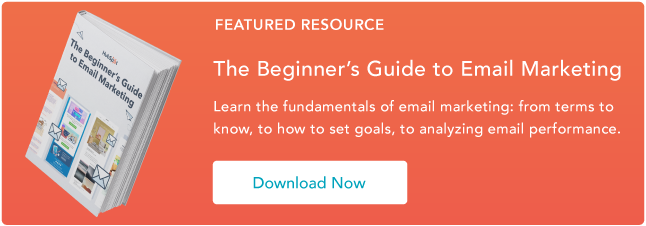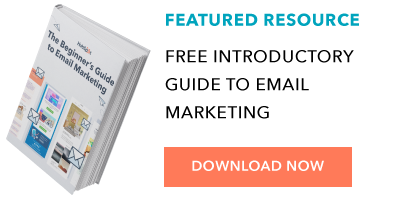This is a guest post written by Jamie Turner, founder of the 60 Second Marketer. He is an in-demand marketing speaker and author of the book entitled Go Mobile with Jeanne Hopkins, former VP of marketing at HubSpot.
While email marketing may not get the attention some newer marketing channels get, it’s still a terrific way for you to generate leads and convert more prospects for your business. With that in mind, I want to share some email marketing best practices you can use to generate more leads for your business.
Email Marketing Best Practices of 2018
- Don’t Purchase Contact Lists
- Use Incentives to Increase Open Rates
- Avoid Using ‘No-Reply’ in the Sender’s Email Address
- Stick to Fewer Than Three Typefaces
- Clean Your Mailing List Regularly
- Keep the Main Message and Call-to-Action Above the Fold
- Personalize the Email Greeting
- Keep Your Email 500-650 Pixels Wide
- Put Your Logo in the Upper Left-Hand Side of the Email
- Write Compelling (But Concise) Subject Lines
- Use Auto-Responders for Opt-Ins
- Closely Tie Emails to Landing Pages
- Conduct a Five-Second Test
1. Don’t Purchase Contact Lists
This first tip should come as no surprise, but given the recent rollout of the General Data Protection Regulation (GDPR), it bears repeating. Email campaigns depend on a healthy open rate, and if you’re contacting people whose information you bought — rather than earned from a previous interaction — you’ll quickly see your emails’ performance drop.
The GDPR also requires each European recipient’s consent before you reach out to them, and purchased email lists usually do not come with that consent.
2. Use Incentives to Increase Open Rates
When you include an incentive in your subject line, you can increase open rates by as much as 50%. “Free shipping when you spend $25 or more” and “Receive a free iPod with demo” are examples of good, incentive-focused subject lines.
However, be careful not to overwhelm your readers with savings- or product-related emails. Customer loyalty starts with casual industry insights — only then can you talk business.
3. Avoid Using ‘No-Reply’ in the Sender’s Email Address
Have you heard of CAN-SPAM? This longstanding piece of legislation is a popular and important guideline for all email marketers in the U.S. — and still many companies are trying to comply with it. One major rule in CAN-SPAM is to never use the words “no reply,” or a similar phrase, as your email sender’s name (for example, “noreply@yourcompany.com”).
“No reply” in an email message prevents recipients from responding and even opting out of further emails, which CAN-SPAN protects their right to do at any time. Instead, have even your automated emails come from a first name (for example, jamie@mycompany.com). Your customers are much more likely to open emails if they know they were written by a human being.
4. Stick to Fewer Than Three Typefaces
The less clutter you have in your email, the more conversions you’ll experience. Don’t junk up your email with more than two, or a maximum of three, fonts or typefaces.
5. Clean Your Mailing List Regularly
Some of your email contacts might not opt-out of your email campaign, but still never open your emails. It’s tempting to email as many people as possible to reach more prospects, but keeping your least-engaged recipients on your mailing list can kill your open rate. People who never open emails make your campaign look worse since you’re not analyzing the campaign’s quality against your most loyal recipients.
Analyze who hasn’t engaged with your emails over a certain period of time, and remove them on a regular basis. This gives you a more accurate email open rate and keeps your email campaign clean of the people who are no longer interested in hearing from you.
6. Keep the Main Message and Call-to-Action Above the Fold
If your main call-to-action (CTA) falls below the fold, as many as 70% of recipients won’t see it. Also, any CTA should be repeated at least three times throughout the email in various places and formats.
7. Personalize the Email Greeting
How often do you read emails that begin, “Dear Member”?
You might segment your email audiences by the type of customer they are (member, subscriber, user, etc.), but it shouldn’t be the first thing recipients see in your company messages. Personalizing the greeting of your emails with your contacts’ first names grabs the attention of each reader right away.
Don’t worry, personalizing an email’s greeting line with 50 recipients’ names doesn’t mean you’ll have to manually write and send 50 different emails from now on. Many email marketing tools today allow you to configure the greeting of your email campaign so that it automatically sends with the name of the people on your contact list — so everyone is getting a personal version of the same message.
8. Keep Your Email 500-650 Pixels Wide
If your email template is wider than 650 pixels, you’re asking users to scroll horizontally to read your entire message. This is even more cumbersome for a recipient who’s reading your email on his or her mobile device. Your email pixel width is a critical component of its lead-capturing ability.
9. Put Your Logo in the Upper Left-Hand Side of the Email
Eye-tracking studies have found that people instinctively look for logos in the upper left-hand side of emails. Put your logo in the upper left-hand side to ensure it gets the most visibility.
10. Write Compelling (But Concise) Subject Lines
A good subject line should contain between 30 and 50 characters (including spaces). Email accounts and mobile devices often cut off any subject lines that go beyond this length. Your email subject line should also create a sense of urgency, while giving readers some indication of what to expect once they open the email.
11. Use Auto-Responders for Opt-Ins
Be prepared for your readers to forget they opted in. Set up an auto-responder that reminds people they opted in to your email database. The auto-responder should be sent out one day, five days, and 10 days after the person registers.
Each auto-responder email should also include additional content or bonus material to reward the reader for opting into the newsletter — or your readers might not feel they have enough incentive to actually opt in.
12. Closely Tie Emails to Landing Pages
Your landing page should match the email in terms of headline, copy, and content. The look and feel of your landing page should also match the email — consistency goes a long way toward a customer’s trust in the content they’re receiving.
Just make sure you’re using tracking tools to see which emails and landing pages performed the best so you can keep sending what’s working.
13. Conduct a Five-Second Test
Send a copy of the email to a friend or business associate. Can they quickly tell what your call-to-action is? If so, you’re golden. If not, keep working.
There are a lot of new tools at a marketer’s disposal that are getting attention these days. But email marketing has stood the test of time regarding its influence on your users. This old, reliable, and faithful tool can really ensure you get the most out of your marketing initiatives.
![]()






